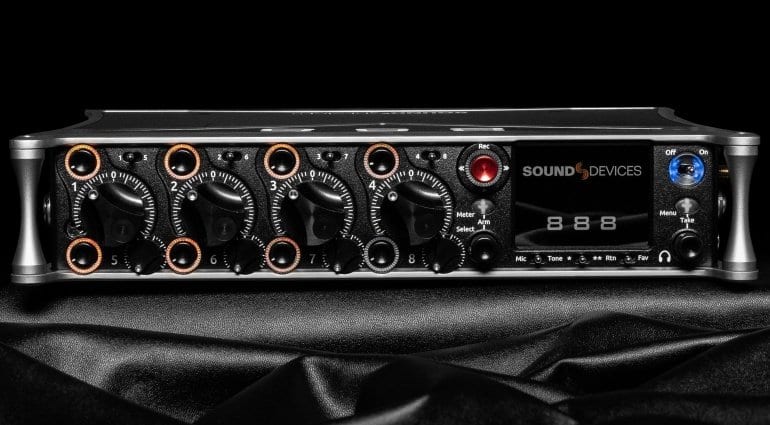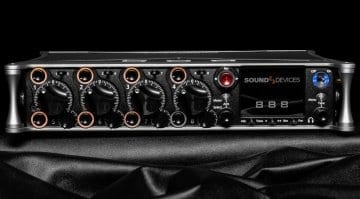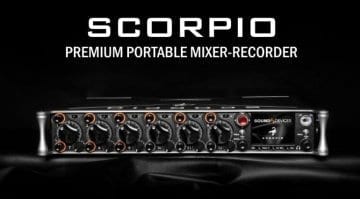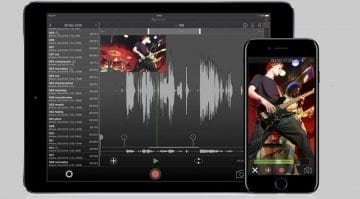Sound Devices brings a 16-channel Dante recorder for filmmakers and sound designers
Manufacturer Sound Devices has homed in on the upper segment of the external recorder market with a considerably souped up line-up. While its MixPre series of recorders-interfaces is carving a name for itself in the echelon above Zoom and TASCAM’s perpetual race to the bottom, the Chicago-Berlin operation has redied a new and even more ambitious offering.
Titled ‘888’, Sound Devices’ newest is a downsized variant of the manufacturer’s 32-channel Scorpio recorder. Compared to the more affordable MixPre series, it takes up Dante audio over Ethernet and doubles down on recording power for a flagship-class offering. Up to 16 channels of Dante I/O are found on it, alongside eight mic preamps on four combo-XLR and four mini-XLR connectors (76dB gain); 16 audio channels on 10 buses and 20 tracks; and a 256GB internal SSD plus two SD card slots.
Throw in a full-color screen, FPGA and ARM-based processing for signal routing (any physical input to any track, bus or output – says the maker), and several power options (dual L-Mount, smart battery, NP-1, DC) – as well as a battery-powered timecode generator, and we end up with a very capable recorder for film and onsite productions.
Design amenities
With its handles and integrated 1/4″-20 threads, the 888 can be placed in a sound bag, attached to a camera/tripod, or slung from a shoulder/neck strap. Large channel knobs, channel trims, PFL switches, and transport joystick are on disposal, and the color touchscreen is sunlight-readable.
Preamps
Sound Devices equipped the 888 with eight Class-A preamps with 76dB of gain, -129dBu noise level, 12V/48V phantom power, and +4dBu line level for incoming audio from wireless receivers. The first XLR input also accepts AES3/AES42 digital signal.
Output extravaganza
The recorder has an extensive array of outputs, including four TA3 jacks, an assignable 3.5mm mini jack, 1/4-inch and 3.5mm stereo headphone outputs, a TA5 headset port, TA3 return jack, and balanced XLR outs. The 888 uses 32-bit converters with 120dB of dynamic range and sample rates up to 192kHz at 24 bits. Signals can be recorded on the SSD and two SD cards simultaneously, formatted in exFAT. The supported audio formats are WAV (broadcast or RF64) and AAC.
Timecode sync
A LEMO jack with 2-pin and 5-pin options enable input and output functionality for timecode and word clock reference signals. Timecode options include free run, auto record, jam sync, and others. The generator’s dedicated battery preserves timecode for up to four hours after shutting down the 888.
Automated Mixing
The 888 has a limiter and a three band EQ which can be set to pre or post-fader for each channel, as well as Dugan Automixing and MixAssist features – capable of operations like automatically attenuating unused mics in a multi-mic scenario and mixing up to 16 channels/2 groups at a time.
Remote Control App
Sound Devices has the SD-Remote app to let you access the 888’s transport controls, metering and sound reports from a touchscreen device. Furthermore, USB MIDI control surfaces by the likes of Icon Platform and Mackie/Behringer, as well as Sound Devices’own CL-12 controller are supported for fader and transport operation.
Price and availability
At USD 6,995 the 888 slots itself between the Sound Devices Scorpio (USD 8,995) and 833 (USD 3,995) to offer a 16-channel field/movie recording solution. Obviously, this is no project studio affair, but rather expert-level gear for filmmakers, sound designers and field recordists. I am not exactly familiar with this market, but I presume these prices are fair for the kind of equipment deployed in such demanding projects.
Self-containment, camera integration and battery power are obviously key technological points that differentiate this type of recorder from a typical high I/O audio interface. But it ought to be noted that this kind of money nets one gear like the Antelope Audio Goliath HD | Gen. 3 or Apogee’s Element series – computer-connected powerhouses that are a rack case and capable laptop away from filling in for a Scorpio, 888 or 832. Then again, a direct comparison isn’t really possible, because it’s an apples and oranges situation. Shop wisely!











